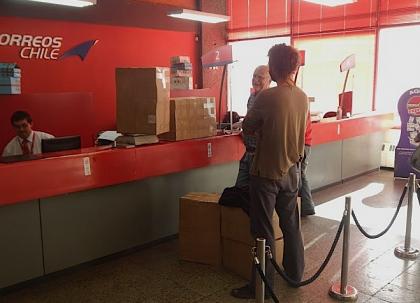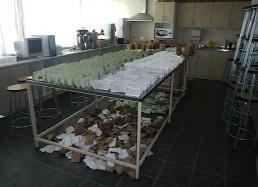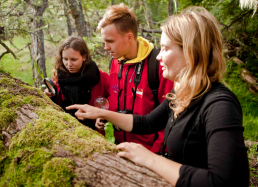Blog #9: Heading Home
We’re back in our hotel, and Blanka and I are finishing up our last vouchers for microscopic photography. I’m very proud of what we’ve been able to accomplish, and I’m excited to share the results with my colleagues back home.
And the discoveries just don’t stop! On our very last collecting trip, Blanka picked up a scrappy-looking liverwort growing on the leaves of a shrub. I don’t even know how she saw it in the field, and I could barely even tell what she’d collected under the dissecting scope.
But as soon as I saw the sample under the compound microscope, I knew immediately what it was: Pigafettoa, a very tiny but darling liverwort that’s only known from a few localities in southern Chile (see Photo #1 below). I’d been looking for it this entire trip, as it was high on my priority list of species. However, I hadn’t ever seen it, and here Blanka scored it as one of her very last collections! I’m thrilled to be able to document its oil bodies, which have never before been examined or photographed.
In any case, even with our wonderful finds, I must admit that we’re all feeling pretty exhausted at this point. Luckily, almost all of our collections are dry, and we’re quickly packing them up and preparing them for shipment (see the above image and also Photo #2 below.) It has been a great trip, and now we get to go home and work through all our collections to determine in greater detail what we’ve found. (Often, we only have time to identify the genus of a plant in the field. Identifying its species takes longer, and not infrequently we’re able to claim the discovery of an entirely new species.)
The number of samples we’ve brought this trip will keep us more than occupied in the coming year before the final season of field work next winter. Our goal is to create comprehensive publications that contain photos, illustrations, descriptions, and distribution maps of species all across the Cape Horn Archipelago. The UNESCO Biosphere Reserve and Omara Ethnobotanical Park can then use this information to monitor populations and habitat health, and institute further measures to protect this unique environment from threats, such as invasive species, commercial development, logging, and more destructive forms of tourism.
And speaking of tourism, our work will also be used to educate visitors to the area (cruise ships often stop along these islands during their trips to Antarctica—see Photo #3 below.) Our field guides and technical contributions to the park’s “Garden of Mosses” will also help visitors learn to appreciate these miniature forests and the many beautiful bryophytes that create soil, clean our air, filter our water, and provide us with potentially powerful medicines.
Also, we’ll continue capacity-building on a local level by participating in workshops and seminars designed to train home-country specialists on the many liverworts, hornworts, and mosses that populate the Archipelago. (Botanists are a dwindling breed worldwide, but those who specialize in bryophytes—the predominate plant along the Archipelago—are especially scarce.) Empowering researchers and citizen scientists through programs offered within the Omara Ethnobotanical Park and at various Chilean universities helps ensure the continued study and preservation of polar biodiversity, only now just beginning to be understood.
I hope you enjoyed following along on our travels, and if you’re interested in learning more about our Cape Horn Project, bryophyte research, or the other conservation work that we do at The Field Museum, please be sure to visit these websites. And if you’d like to support our project, please consider donating to our Botany Department. Securing long-term sustainability for hotspots of biodiversity worldwide is a newer and tougher challenge for the Museum, and funding is crucial to the success of our efforts, so we appreciate your contributions!
Thank you for joining me on my journey—until next time,
Laura








